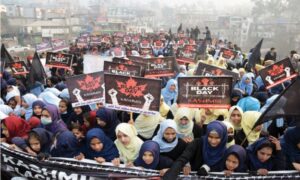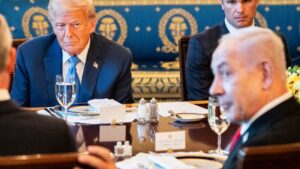
More than a decade ago, a young Kashmiri fighter named Burhan Wani captured the imagination of Kashmiris. SA-born journalist Azad Essa reports.
In the summer of 2016, 22-year-old Burhan Muzaffar Wani and his band of rebels quietly entered the apple orchards of south Kashmir’s Bemdora Kokernag when Indian armed forces cordoned off the area. A social media phenomenon, young, he represented and symbolised a new era of armed resistance against Indian rule. His killing in July 2016 at the hands of Indian troops sparked an uprising across the region. Almost 10 years after his death, his memory still hovers over Kashmir.
A gunfight soon erupted between Burhan and Indian armed forces.
Burhan, then the top rebel commander of armed outfit Hizbul Mujahideen, was killed first.
He was followed by his two companions, Sartaj Ahmad Sheikh and Pervaiz Ahmad Lashkari.
News of his martyrdom enveloped Kashmir in grief and unfathomable rage. Shops were closed. Streets were desolate. This desolation was only broken with the chants of Azaadi and the stone pelting of armed forces by young men. The valley, known to be “paradise” on earth, was on fire that day.
Over the next several months, Kashmir became an open-air prison.
An indefinite curfew was imposed over large swathes of the Kashmir valley.
For Indians, Burhan was simply a terrorist.
But for hundreds of thousands of Kashmiris who defied the Indian-military imposed curfew to attend his funeral in south Kashmir’s Tral district, Burhan was a symbol of a stirring defiance against Indian rule.
Many Kashmiris said that they had never seen such a large rally in their life.
Why Kashmir loves Burhan
When Burhan was 15, he was, along with his brother, arbitrarily picked up and mercilessly beaten and tortured by Indian forces. The experience motivated him to join the armed resistance against Indian rule. Kashmiris understood it all too well. His humiliation was theirs.
But when Burhan refused to hide behind a mask as he announced his fight against Indian rule, his courage lent a certain esteem to the Kashmiri struggle for self-determination. Each photo posted on social media in which he was seen dressed in fatigues and holding a weapon was an act of defiance against one of the world’s largest armies. In his videos – which are close to impossible to locate on the internet today – he would address the injustice faced by Kashmiris and urge them to join the fight against India.
Burhan was a rebel of the digital age. He became the face of Kashmiri resistance, shattering India’s narrative that armed rebels were from Pakistan or, when they were from Kashmir, they were poor and uneducated and were being manipulated or paid to pick up arms against Delhi.
Burhan was born into a highly educated upper-class Kashmiri family.
His father, Muzaffar Wani, was the principal of a government school and his mother, Maimoona Muzaffar, holds a postgraduate degree in science. The family was quite well-off financially.
After his killing, protests broke out across the valley.
Thousands of armed forces were seen patrolling the streets, barricading the areas with barbed wire and warning people to stay indoors.
Despite all the measures taken to control the situation, angry Kashmiris took to the streets across many parts for days and pelted stones at the Indian armed forces, who responded with live fire, tear gas, and pump-action shotguns that shot lead-plated pellets. Dozens were killed and hundreds of others injured.
Many Kashmiris, including teenagers under 15, were shot with pellets in the eyes and left blind; some died from their pellet wounds.
When the unrest didn’t dissipate – despite the heavy military presence in the region – hundreds more troops were sent to Kashmir to restore order. The violence was the worst seen in the valley for years.
Knowing that his killing could lead to a massive uprising, they suspended the annual Amarnath pilgrimage.
Phone services were shut down in south Kashmir, while mobile internet was blocked across the region to prevent any sort of mobilisation of anti-India protests.
Business establishments, government offices, educational institutions, train services, and shops—everything came to a halt due to curfew and hartal calls by the pro-freedom leaders.
Burhan had warned local police of the “consequences” if they continued to resist the freedom movement.
He was seen as a big threat by the Indian government, which is why they declared his killing as “the biggest success against militants” at the time.
He was young, relatable, charismatic, and a popular rebel who connected with the youth like no one before by using his social media effectively. In doing so, he attracted many young boys towards the cause of freedom.
With his death, a large number of youth, especially in south Kashmir, followed his path.
In the following years, hundreds of young men were killed in counterinsurgency operations, and dozens of civilians, many of whom were accused of providing rebels aid or an escape during gunfights, were shot dead.
And even when the protests subsided, the Indian government continued to impose restrictions on 8 July, including a strict curfew in Tral, Burhan’s hometown.
The 2016 uprising didn’t end in weeks; it continued for more than half a year.
Delhi abrogated Jammu and Kashmir’s special status in August 2019, which ended Jammu and Kashmir’s special status.
Now there is a deafening silence in the valley where journalists are jailed and harassed for writing; human rights activists are accused of terrorism and held without charge; and thousands of young people and political leaders are picked up in midnight raids and linger in different jails.
The Indian government introduced several new laws aimed at changing land ownership and residency rights in the region. These laws allowed non-residents to buy land and apply for domicile status, which was earlier restricted to permanent residents. The government stated that these changes were made to promote development and integration with the rest of India.
However, Kashmiris fear that the laws could lead to demographic changes by encouraging settlement from outside the region.
Today, there are hardly any protests held. No anti-India sentiment is tolerated. If anyone dared, they would end up behind bars. Kashmir has always been known as the world’s largest open-air prison. Rightly so.
After 2019, the Indian government thrived on many narratives.
One of these stories cultivated by the Indian government was that the resistance was dead.
But every other week, there would be gunfights in different parts of Kashmir, which later moved to Jammu.
The defiance lives.
To this day, Kashmiris quietly remember Burhan and his resistance. Whether they express it openly or bury it in silence, the spirit of defiance lives on.
*Azad Essa is a senior reporter for Middle East Eye based in New York City. He worked for Al Jazeera English between 2010 and 2018, covering southern and central Africa for the network. He is the author of: ‘The Moslems are Coming’ (Harper Collins India) and ‘Zuma’s Bastard’ (Two Dogs Books).










